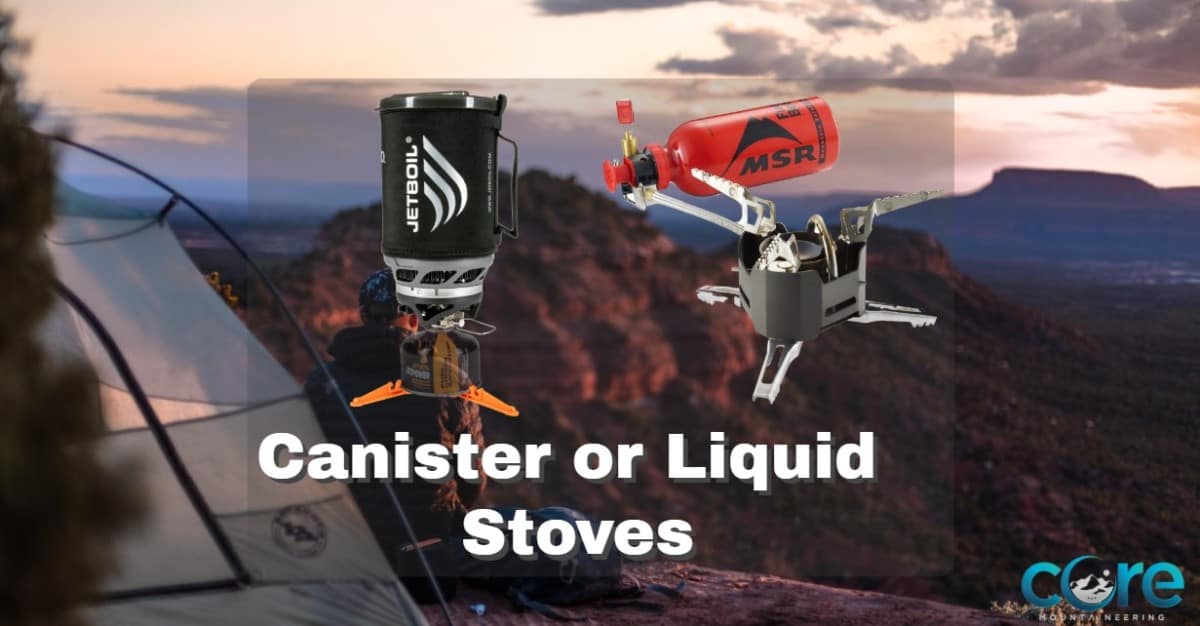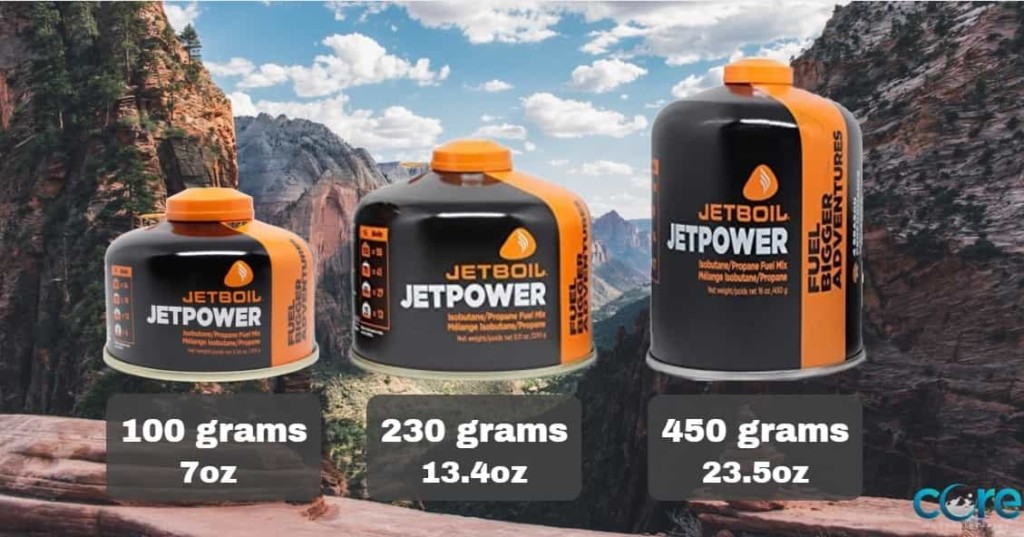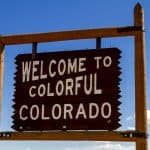Deciding on the right type of fuel for backpacking depends on convenience and where you’ll be hiking. Typical, canister gas is the most common fuel type for its convenience and pre-measured amount of fuel. These canisters screws onto the bottom of a camping stove. If you’re adventuring out to freezing weather and high altitudes a pearl of conventional wisdom is that liquid-fuel stoves work best.
While there are many different types of fuels available to use, let’s focus on canisters and liquid types so you can be prepared for anything.
Liquified Petroleum Gas Canisters (LP Gas) Stoves
These camping gas canister typically uses a blend of propane, isobutane and butane. This fuel is in the general class of Liquefied Petroleum Gas (LPG). They are single-use, non-refillable. They have become popular over the years because they don’t take measuring and perform well in most conditions.
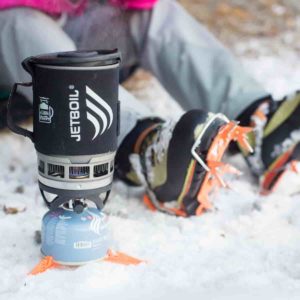
Fuel Canister Sizes
They come in a few different quantities. 100g, 230g, and more massive 450g. Determining how much fuel you need comes down to how many boils of water you’ll get from the canister. A few factors will play into how many boils you’ll get from your fuel. Wind, temperature, attitude and the stove itself.
How Much Fuel Is Left in the Canister
I get about 12.5 boils out of 100 grams of fuel with 500ml of water each time. An empty 100g canister will weight 92g. So if you weight the fuel canister at home and it’s 152g, then you know you’ll have around a little over 7 more boils left in that canister. I also recommend when you get home from a camping trip to weight the canister and use a post-it or Sharpie to mark how many boils are left.
The most significant factor in canister usage is the stove itself. An open flame stove or a more contained flame stove like a Jetboil. A Jetboil camping stove will cut down on how much fuel per boil dramatically. While other, open flame stoves perform well but are not as fuel-effective.
I always bring my Jetboil and a backup stove just in case. I’m using my Jetboil every chance I get. It uses less fuel by nature it’s constructed, cutting down the need for a windshield.
Best Canister Camping Stoves
This is the standard Jetboil that I use. These are more fuel-efficient due to the way the heating surface is designed. The included boiling pot has a heat exchanger attached to the bottom.
I also like this because it’s an all in one system with a measuring bowl included. It has a reliable push-button igniter that’s never failed on me. I’ve had mine for over ten years and see no need to upgrade.
Included are little legs for stabilization and color indicated insulated sleeve. The system packs nicely together with the fuel sliding into the cup when packing it into a backpack. Check you the current price of the Jetboil on Amazon here.
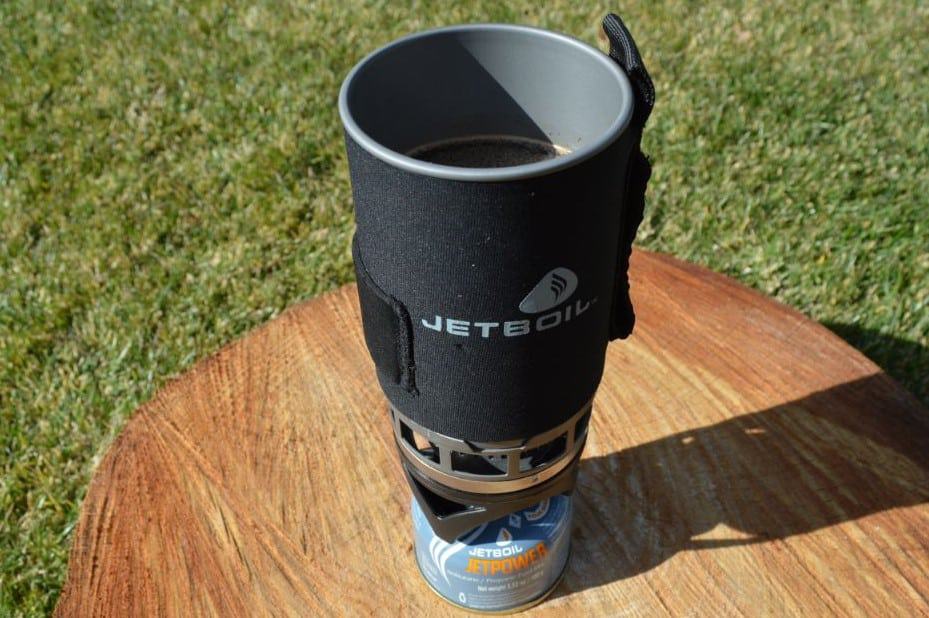
When you only need the stove part or not interested in an entire cooling system look no further than the MSR PocketRocket 2 Ultralight stove. MSR is known for there high quality, they made a name for themselves in high altitude stoves. This is one of the reasons they have become one of the most trusted brands in backpacking stoves.
The MSR PocktRocket 2 is lightweight at 2.6oz. It is also small enough to fit in any pocket on the outside of your backpack, for quick access. It’s also much cheaper than the Jetboil. Check out the current price of the MSR PocketRocket 2 on Amazon here.
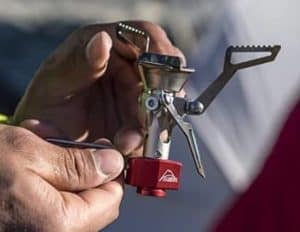
Liquid Camping Fuel Stoves
While a liquid camping fuel setup will be bulkier and more substantial than gas canister stoves, they offer superior cold weather and high altitude performance. The heat coming for the flame will be consistent in warm and cold temperatures. Canister fuel can sputter in cold weather but liquid fuel will not.

What is White Gas?
All liquid fuel stoves will be able to burn white gas. This is a clean, very pure form of gasoline that does not contain any additives. If your stove was made for international use, it might also be able to use cheaper, dirtier fuels like diesel, kerosene, unleaded fuel, or even jet fuel. These fuels are more readily available in places that do not have pure, specialized camping stove fuels.
The reason why you’d want to avoid these cheap dirty fuels is that they will clog your stove, resulting in frequent cleanings. If clean fuel is available in your area, you’re better off using it.
Bring The Right Amount of Fuel
The canisters come in a few different sizes, so you are stuck with sizes manufacturers make. If you’ll only be camping for a day and only plan to use two burn boils you’ll be bringing unused fuel home. With liquid stoves, you’ll only take what you need.
If you’re only going to need a few boils then bring less than a 100g of fuel. There’s no need to carry extra weight when every ounce counts while hiking.
Unlike canisters, liquid fuel will perform the same with only a little bit of fuel left. Canister fuel, on the other hand, gives a lower output as the internal pressure drops.
Canister Camping Stoves VS. Liquid Camping Stoves
Let’s compare the advantages and disadvantages of both systems to determine what will be best for you.
Stove Maintenance
Canister hiking stoves are about as low of maintenance you’re going to get. Since they must use clean fuel filled from the manufacturer, they are unlikely to ever get clogged. Liquid hiking stoves are reliable and low maintenance as well, but they will need to be clean just about every year or more.
The good news is they are easy to clean and repair when needed. Cleaning and repair kits can be purchased from the manufacture. MSR has videos for proper care and maintenance for all there stoves.
Backpacking Stove Weight
Weight saving is in the canister stoves favor. Compare MSR PocketRocket 2 ultralight backpacking stove weighing in at 2.6oz to MSR whisperLite coming in at 11.5oz. When it comes to size and weight, canister stoves are the clear winner.
Stove Fuel Weight
This is where planning your fuel for how many boils you’ll need comes in handy. I have brought an extra canister with me hiking because I wasn’t sure how much fuel was in them. I didn’t want to run out, so I would throw an extra 100-gram canister in my pack just in case.
Liquid fuel can be measured out exactly how much you’ll need, saving weight by bringing less fuel up and down a mountain. If it’s only a one day trip, a single canister stove will be lighter and more covenant.
Low Temperature
Liquid stoves will perform the same at low temps as they do in warm weather. As temperatures lower, the pressure in fuel canisters drops, lowering performance. This effects canisters more as they empty, reducing pressure.
If you plan on some very cold freezing nights, consider a liquid stove.
Cost of Canister VS. Liquid Fuel Stoves
When just looking at these two different stoves themselves canister stoves are cheaper. This doesn’t paint the whole picture because, in the long run, liquid stoves are cheaper to operate. This is due to the cost of fuel. Canister stoves have to use canisters, while liquid stoves can use many different fuels.
An hour of burn time with a canister will cost around $7. While an hour of burning a white gas will be about $2. This adds up in the lifetime usage of a stove. The estimate for the canister is using an ordinary stove with no wind protection. The cost of an hour burn will go down when adding a wind block, or using a stove such as a Jetboil.
The container for the liquid fuel stoves will be reused. This is a plus for these stoves and a significant downfall for canisters. Canisters can’t be reused, so they end up in the trash. If you’re concerned about your ecological footprint, it’s another good reason to use liquid fuel stoves.
Camping Fuel Availability
This guide is focused more on the beginner adventure, but fuel availability is still something to think about. When purchasing an outdoors stove, I like to think of it as a lifetime purchase. A piece of camping gear that will last for decades.
If you ever think you might travel international a liquid fuel stove is a clear winner. From diesel, kerosene, unleaded fuel, or jet fuel you can rest assured wherever you go, you’ll be able to find fuel.
Choose a Stove for Different Scenarios
Let’s go over a few different scenarios to help decide on which stove will fit your needs.
Weekend Backpacking Trips
If you want the fast quick answer for which stove to choose for “normal” 3-season camping, then use a canister stove. There is no need to mess around with a liquid stove if you’re only going out a few times a year, in moderately warm weather. A 230g canister of fuel can last all year if used sparingly.
This kind of camping is some of the most relaxing, and almost always above freezing. Easy to cook meals for the kids, and about a minute to warm up water for coffee in the morning. A canister stove will be perfect in this situation.
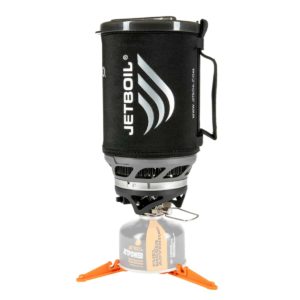
For this type of camping and hiking, I highly recommend a Jetboil (weighs 12oz). They light up and stay lit in high winds, and mine has been dependable for over ten years so far. Check out the current price of the Jetboil on Amazon here.
Alternatively, if you only want the stove that screws onto the gas canister without a boiling cup, check out MSR PocketRocket 2 Ultralight Backpacking (2.6oz). This only includes the stove so you’ll still need a pot for boiling water.

Long Backpacking Trips
The more time spent out hiking, decisions on weight become more important. Having a hiking stove with you that performs well in the cold or below freezing, that is versatile and lightweight and is great for extended backpacking trips.

For backpacking in this scenario, I recommend the MSR WhisperLite Universal Canister and Liquid Fuel Stove. It’s not as heavy-duty as a liquid mountaineering stove and still uses canisters, as well as other forms of fuel. This stove weighs in at 11.5oz.
Check out the current price of the MSR WhisperLite stove on Amazon here.
Mountaineering Stove
Deciding on a stove for extreme conditions means using a high-quality stove made for those conditions. Even if you don’t plan on going into freezing conditions high in altitude, but you want to be prepared take a look at the MSR XGK EX Extreme-Condition Camping and Mountaineering Stove.
MSR is known for high-quality reliable stoves that Alpinist rely on. This is the most reliable extreme-condition stove available on the market. It comes in at 13.4oz, features a flexible fuel tube to make it more compact for storage. See the current price of this MSR stove on Amazon here.

Other factors go into choosing a stove, but I just wanted to keep this clear and straight for a beginners guide. If you are just getting out in the outdoors for the first time or just want an upgrade, I hope this information has been helpful. Comment down below if you can recommend a good stove and how it has performed.
I recommend other gear with everything being tested by me. Many pieces of gear like dry bags and backpacks I’ve spent tons of hours and research on. Please check out The Recommended Gear page here!

